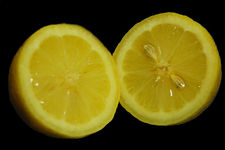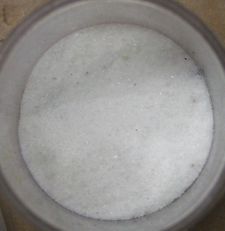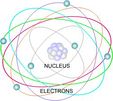Is Ascorbic Acid A Good Source Of Vitamin C
| Ascorbic acid | |
|---|---|
  | |
| General | |
| Systematic name | 2-oxo-L-threo-hexono- 1,4- lactone-2,3-enediol |
| Other names | Vitamin C L-ascorbic acid |
| Molecular formula | C6H8O6 |
| Molar mass | 176.13 g/mol |
| Appearance | white to pale yellow crystalline powder |
| CAS number | 50-81-7 |
| Properties | |
| Density and phase | 1.65g/cm3 |
| Solubility in water | 400000 mg/L(40°C) |
| Melting point | 190 °C (decomposes) |
| Acidity (pK a) | 4.7 (at 10°C)[1] |
Ascorbic acid is also known as Vitamin C. Humans can not make ascorbic acid on their own so they have to receive it from the food that they eat. It is a white to light yellow crystalline powder with pleasant, sharp acidic taste.[2] Ascorbic acid can be found both naturally and synthetically. Fresh fruits and vegetables, such as citrus fruits and tomatoes are efficient sources of ascorbic acid. Vitamin C is essential in our body and lack of Vitamin C will cause people to get scurvy which is a disease marked by swollen and bleeding gums, livid spots on the skin, and prostration. It is needed for many of our biological processes, such as combining and repairing body tissues. High concentration of ascorbic acid exists in many tissues in our body; such as, liver, leukocytes, platelets, glandular tissues, and the lens of the eye.[3]
Properties
Ascorbic acid is a white to light yellow crystalline powder with pleasant, sharp acidic taste. It is odorless and is stable but can be weaken by light or air. It doesn't combine with oxidizing agents, alkalies, iron or copper. Ascorbic acid is a organic compound that occurs naturally with antioxidant properties.[2] Ascorbic acid is a water-soluble and sometimes soluble in ethanol. In most cases, it cannot be soluble in ether and chloroform. Ascorbic acid should be stored in a tightly closed, non-metallic container and protected from air and light.[3]
Air and alkaline media oxidize ascorbic acid solution quickly. Exposure to light makes ascorbic acid gradually darker. Nevertheless, slight change of color does not affect the therapeutic activity of ascorbic acid injection. Also, a humid atmosphere gradually degrades ascorbic acid even without light exposure. As temperature increases, the rate of decomposition increases. There is a possibility that ascorbic acid may decompose with the production of carbon dioxide when the concentration is greater than 100 mg/ml. Ampoules containing ascorbic acid injection should be opened carefully because the pressure increases after storing for long time.[3]
Occurrences

Lemon contains high amount of vitamin C
Ascorbic acid can be found naturally and synthetically. Naturally, ascorbic acid is found in fresh fruits, vegetables and animals. Fresh fruits and vegetables are efficient sources of ascorbic acid.[3] Citrus fruits are the best sources of ascorbic acid. Apples, pears, melons, peaches, bananas and grapes contain 3-10mg/100g, tomatoes have 15mg/100g, oranges, lemons, grape-fruit, strawberries contain 40-80mg/100g. Moreover, black currants have 140mg/100g, rose-hips have more than 500 mg/100g and the hips of Rosa oxyodon contain 7000mg/100g. For infant, one ounce of orange juice can fulfill the daily need of ascorbic acid which contains 25 mg of ascorbic acid.[4] We can't get sufficient ascorbic acid from animals. Eggs, cheese, edible oils and fats contain no vitamin C. Meat and Milk contain low amount of ascorbic acid (2mg/100g). Human milk contains 5 to 7 mg/100ml while cow's milk contains 1.0 to 2.6 mg/100ml. For some animal organs like kidneys and livers contain 14mg and 25mg/100g.[5]
Uses

Ascorbic acid is a white crystalline powder
Humans cannot produce ascorbic by themselves, therefore they must receive it externally. Ascorbic acid prevents and cures scurvy, which is vitamin C deficiency. It has been used as a urinary acidifier. For premature infants who are on high-protein diets, it cures tyrosinemia. Also it can cure idiopathic methemoglobinemia. Patients who have diarrhea or GI diseases can get better by taking ascorbic acid. Ascorbic acid combines collagen and repairs tissue in our body. It is a cofactor in many biological processes. For example, the conversion of dopamine to noradrenaline, the hydroxylation steps in the synthesis of adrenal steroid hormones, tyrosine metabolism, conversion of folic acid to folinic acid, carbohydrate metabolism, the synthesis of lipids and proteins, iron metabolism, resistance to infection, and cellular respiration are the processes that need ascorbic acid. It can also clean oxygen in our body. Mostly, ascorbic acid is taken orally in extended-release capsule form, tablets, lozenges, chewable tablets, solutions and extended-release tablets and capsules. When malabsorption occurs, ascorbic acid can be administered intravenously, or subcutaneously. Ascorbic acid with its sodium, potassium, and calcium salts are used as antioxidant food additives.[3]
Ascorbic acid in our body
High concentration of ascorbic acid exists in many tissues in our body. It can be found in the liver, leukocytes, platelets, glandular tissues, and the lens of the eye. About 25% of the ascorbic acid bonds with proteins in the plasma. If people do not have enough ascorbic acid, it causes health problems such as scurvy. People can die from scurvy if they do not get a treatment. Symptoms of scurvy include bleeding gums, and skin discoloration; weak immune systems is another symptom of scurvy.[3]
People can also have to much ascorbic acid. When the body cannot absorb any more ascorbic acid, the leftover moves out through the urine. On the other hand, low or none of the ascorbic acid comes out when the body needs it. If they have too much ascorbic acid, their blood can receive too much iron from plant foods. Another thing that can happen is having to much uric acid in your urine. Taking too much ascorbic acid everyday can form kidney oxalate stones. Also it may disturb water and electrolyte balance, increased red cell lysis, rebound scurvy, renal calcification and suppression of cobalamine activity.[3]
Video
According to the research, almost all of vitamin C supplements have maximum of 20% absorption. There are two forms of vitamin C, Asocrbic acid and Sodium ascorbate, that have been researched and concluded to have no harmful side effects when we take them orally.
References
- ↑ Ascorbic Acid "Pubchem".Web. 14 Apr. 2016-accessed. Unknown Author.
- ↑ 2.0 2.1 Vitamin C "ChemSpider".Web. 14 Apr. 2016-accessed. Unknown Author.
- ↑ 3.0 3.1 3.2 3.3 3.4 3.5 3.6 Ascorbic Acid "Inchem".Web. 14 Apr. 2016-accessed. Unknown Author.
- ↑ Eekelen, Van. The Occurrence of Vitamin C in foods "journals.cambridge.org".Web. 14 Apr. 2016-accessed.
- ↑ Vitamin C "Studyandexam".Web. 14 Apr. 2016-accessed. Unknown Author.
| v•d•e | ||
|---|---|---|
| Featured articles | Atom • Biotechnology • Chemical bonds • Chemical series • Substances • Compounds • Chromatography • Electrons • Energy • Elements • History of the Periodic Table • Ion • Microscopy • Nuclear chemistry • Nuclear weapon • Organic compound • Periodic table • Radioactive decay • State of matter |  |
| Compounds | Acid • Alcohol • Amine • Amino acid • Anion • Base • Carbohydrate • Chloride • Carboxylic acid • Electrolyte • Hydrocarbon • Hydroxide • Inorganic compound • Ion • Isomer • Lipid • Nucleotide • Nitrate • Organic • Phenol • Polyatomic ion • Protein • Resonance structure • Salt • Sugar • Sulfate • Sulfide | |
| | ||
Is Ascorbic Acid A Good Source Of Vitamin C
Source: https://www.creationwiki.org/Ascorbic_acid

0 komentar:
Posting Komentar